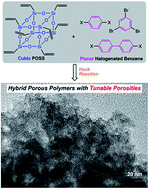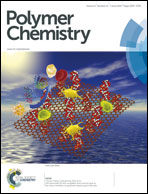Constructing hybrid porous polymers from cubic octavinylsilsequioxane and planar halogenated benzene†
Abstract
Heck coupling of cubic octavinylsilsequioxane (OVS) with planar di-/tri-halogenated benzene (1–5) results in a series of inorganic–organic hybrid porous polymers (HPPs). These materials show high thermal stability and tunable porosities with Brunauer–Emmett–Teller surface areas ranging from 479 m2 g−1 to 805 m2 g−1 and with the total pore volume ranging from 0.33 cm3 g−1 to 0.59 cm3 g−1. Porosity comparison reveals that monomer species and reaction conditions strongly affect the surface area, pore volume and microporosity. For the monomer species, monomers with high reactivity, long strut length and more connectable sites are beneficial to enhance the surface area and pore volume. For the reaction conditions, the conditions which can result in high levels of coupling degrees and the choice of N,N-dimethylformamide (DMF) as the solvent can also enhance the porosity. However, long monomer strut length may also lead to lower surface area and pore volume. DMF tends to increase the level of microporosity and increasing connectable sites may afford more mesopores. These results suggest that these comprehensive factors should be carefully considered when preparing new porous polymers with controllable porosity. In the application, HPP-3 possesses a moderate carbon dioxide uptake of 1.38 mmol g−1 (6.1 wt%) at 273 K and 0.68 mmol g−1 (2.99 wt%) at 298 K when measured up to 1 bar. HPP-3 shows a high binding ability with CO2 with an isosteric heat of 35 kJ mol−1 at low coverage, making these materials become promising candidates for storing and capturing CO2.


 Please wait while we load your content...
Please wait while we load your content...